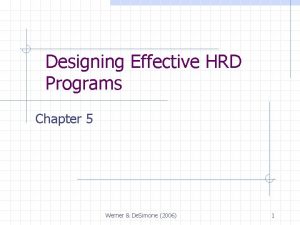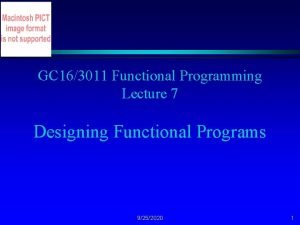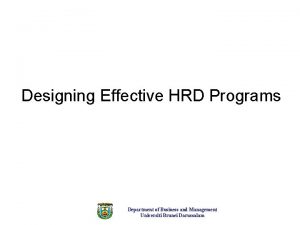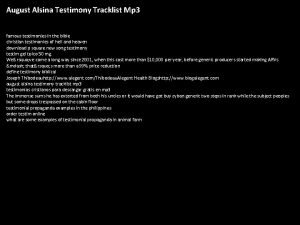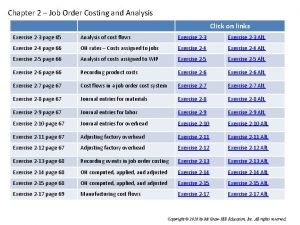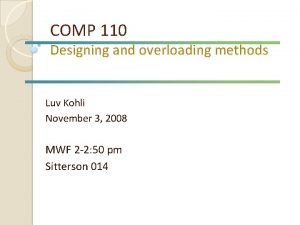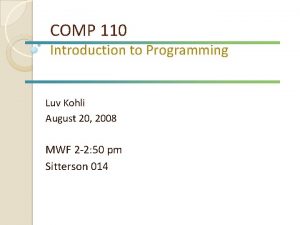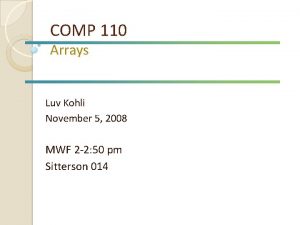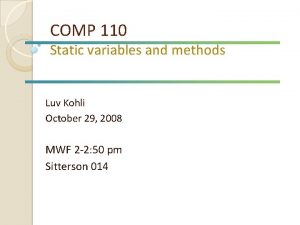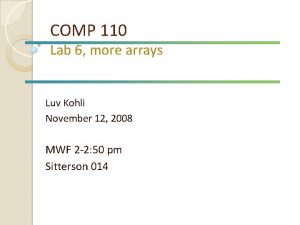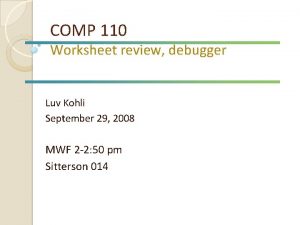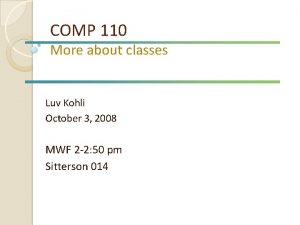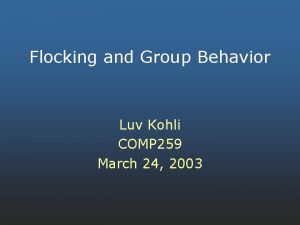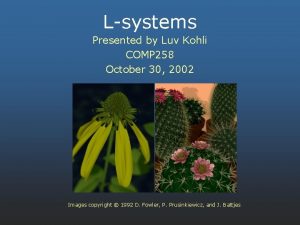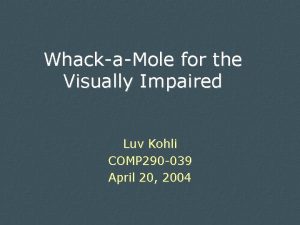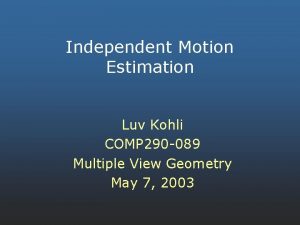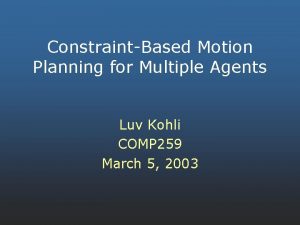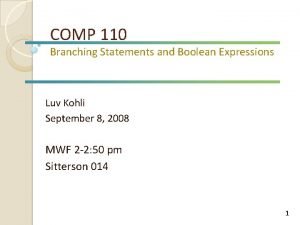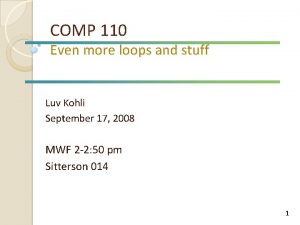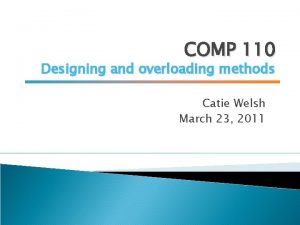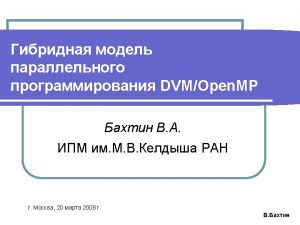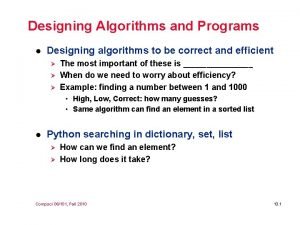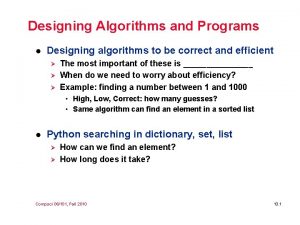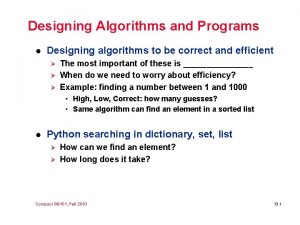COMP 110 Designing Programs Luv Kohli August 27



























- Slides: 27

COMP 110 Designing Programs Luv Kohli August 27, 2008 MWF 2 -2: 50 pm Sitterson 014 1

Announcements Office Hours ◦ After class today ◦ Come if you don’t have j. GRASP working 2

Questions? 3

Today in COMP 110 Writing algorithms in pseudocode Variables and primitive types

Fun exercise time 5

Algorithm A set of instructions for solving a problem 6

Pseudocode combination of code and English used to express an algorithm before writing algorithm into code 7

Variables Used to store data in a program The data currently in a variable is its value Name of variable is an identifier Can change value throughout program Choose variable names that are meaningful!

Variables and Memory A variable corresponds to a location in memory variable n 1 • Use this cell to store the value of n 1 main memory • Prevent this cell from being used by other variables later

How to use variables Declare a variable Assign a value to the variable Change the value of the variable

Variable Declarations Syntax: ◦ Type Variable_1, Variable_2, …; Examples: ◦ int count, score, my. Int; ◦ char letter; ◦ double total. Cost, ratio; ◦ int fjiofeu; // not a useful name! 11

How to name a variable Letters, digits (0 -9), underscore (_) First character cannot be a digit Java is case sensitive Legal names ◦ pink. Floyd, the_coup, b 3 atles Illegal names ◦ michael. bolton, kenny-G, 1 CP 12

Keywords Reserved words with predefined meanings You cannot name your variables keywords if, else, return, new See Appendix 1 in the textbook 13

Type What kind of value the variable can hold. Two kinds of types. ◦ Primitive type - indecomposable values Names begin with lowercase letters int, double, char, boolean See section 2. 1 for a full list ◦ Class type - objects with both data and methods Names begin with uppercase letter Scanner, String 14

Primitive Types Integer (byte, short, int, long) ◦ 0, -3, 5, 43 Floating-point number (float, double) ◦ 0. 5, 12. 4863, -4. 3 Characters (char) ◦ A, r, %, T Boolean (boolean) ◦ true, false 15

Primitive Types: small to big

Variables and Memory When declaring a variable, a certain amount of memory is assigned based on the declared primitive type int age; double length; char letter; main memory

Assignment Statements Change a variable’s value Syntax: ◦ variable = expression; Example: ◦ sleep. Needed = 8; ◦ sleep. Desired = sleep. Needed * 2;

Behind the statement variable = expression; ◦ CPU calculates the value of the expression. ◦ Send the value to the location of variable. sleep. Desired = sleep. Needed * 2; ◦ Calculate sleep. Needed * 2 Get the current value of sleep. Needed from its memory location ◦ Assign the value to the location of sleep. Desired

Specialized Assignment Operators length *= 5; // is the same as length = length * 5; age ++; // is the same as age = age + 1;

Assignment compatibilities Usually, we need to put values of a certain type into variables of the same type However, in some cases, the value will automatically be converted when types are different int age; age = 10; double length; length = age ;

Assignment Compatibilities byte->short->int->long->float->double ◦ my. Short my. Int; ◦ my. Byte my. Long; ◦ my. Float my. Byte; ◦ my. Long my. Int; 22

Type Casting You can ask the computer to change the type of values which are against the compatibility. my. Float = my. Double; my. Byte = my. Int; my. Short = my. Float; my. Float = (float)my. Double; my. Byte = (byte)my. Int; my. Short = (short)my. Float; 23

Arithmetic Operators Unary operators (more info later) ◦ +, -, ++, --, ! Binary arithmetic operators ◦ *, /, %, +, rate*rate + delta 1/(time + 3*mass) (a - 7)/(t + 9*v) 24

Modular Arithmetic - % “clock arithmetic” ◦ Minutes on a clock are mod 60 Remainder 7 % 3 = 1 (7 / 3 = 2, remainder 1) 8 % 3 = 2 (8 / 3 = 2, remainder 2) 9 % 3 = 0 (9 / 3 = 3, remainder 0) 25

Homework Program 1 is on the web page We will look at code in recitation that will help you

Friday Recitation (bring charged laptop and textbook) Lab 1 Programming help for Program 1 27
 Rashmi kohli
Rashmi kohli I love me mudder
I love me mudder Ks kohli
Ks kohli Lee vor luv beispiele
Lee vor luv beispiele Numero niss
Numero niss 100 011
100 011 Comp sci 110 northwestern
Comp sci 110 northwestern Designing and implementing brand marketing programs
Designing and implementing brand marketing programs Designing and developing effective hrd programs
Designing and developing effective hrd programs Base case analysis example
Base case analysis example Obero spm
Obero spm Designing and developing effective hrd programs
Designing and developing effective hrd programs Designing and implementing brand architecture strategies
Designing and implementing brand architecture strategies Designing marketing programmes to build brand equity
Designing marketing programmes to build brand equity Overview of software engineering
Overview of software engineering Themes in fences by august wilson
Themes in fences by august wilson Moric august benovsky dennik
Moric august benovsky dennik April may june july august
April may june july august August alsina testimony download
August alsina testimony download Starr company reports the following information for august.
Starr company reports the following information for august. Julie august
Julie august August journal prompts
August journal prompts Sikavica joler
Sikavica joler Carl jonas love almqvist kända verk
Carl jonas love almqvist kända verk Light in august summary
Light in august summary Alex gyori
Alex gyori August shi
August shi August kekulé
August kekulé








